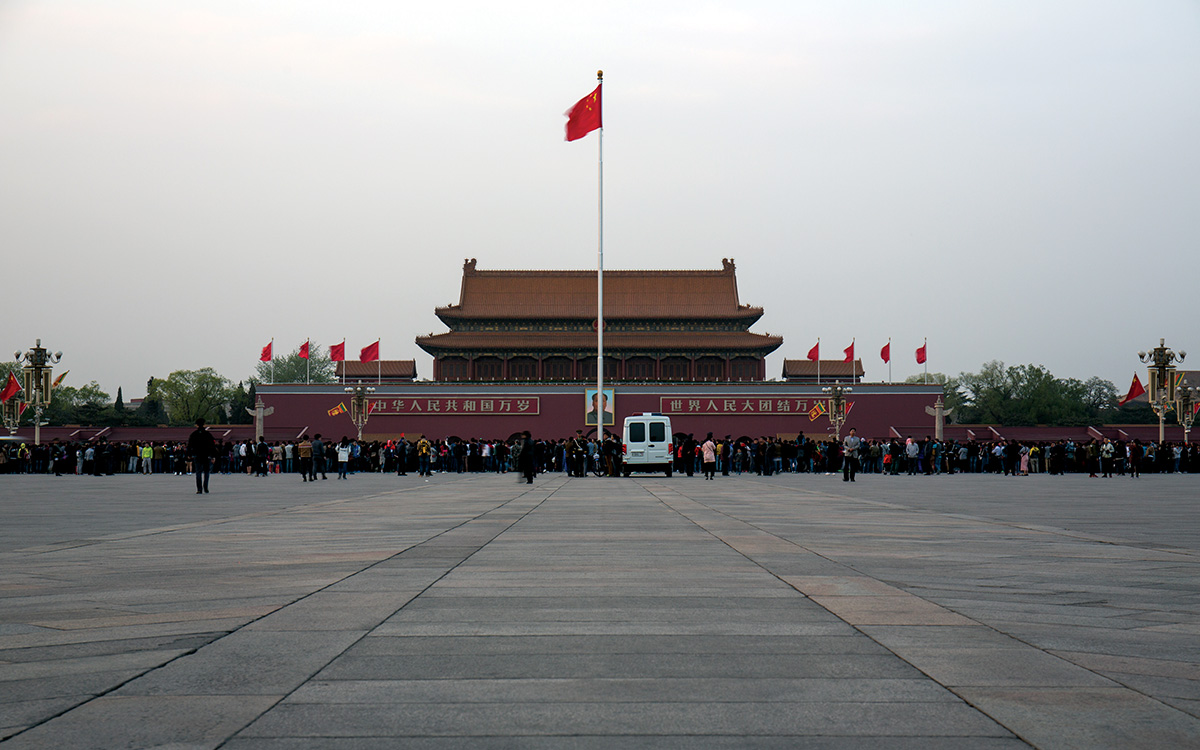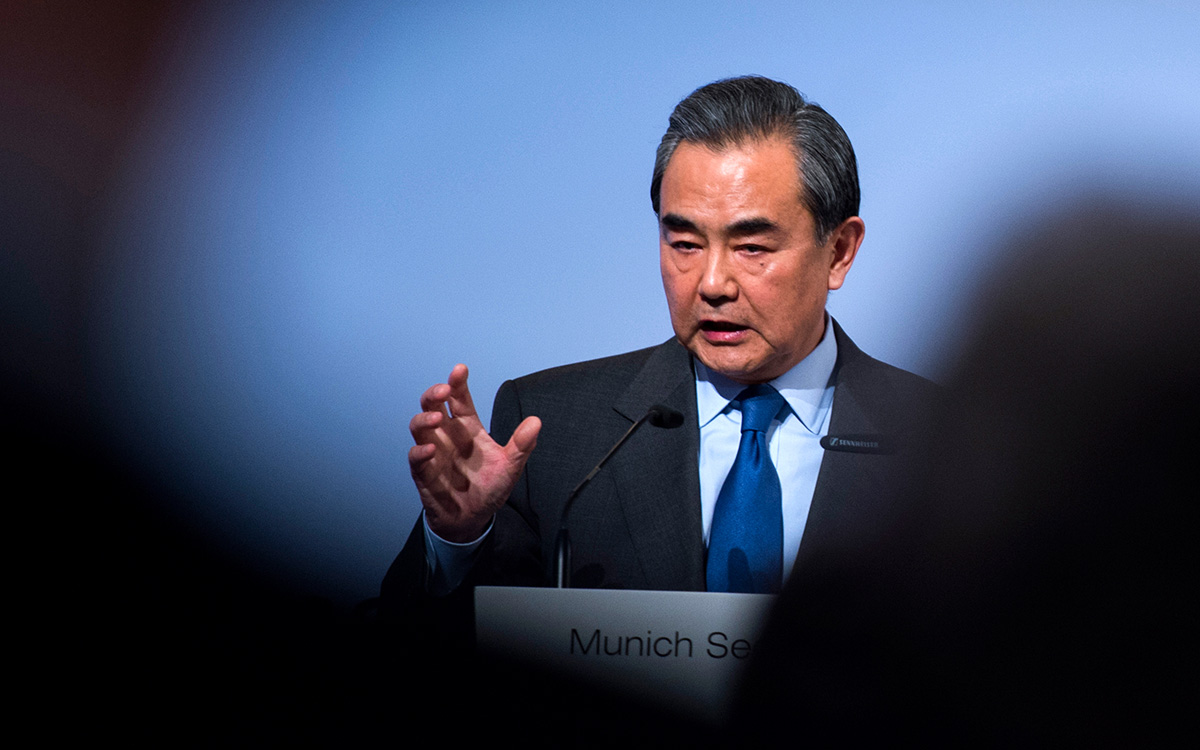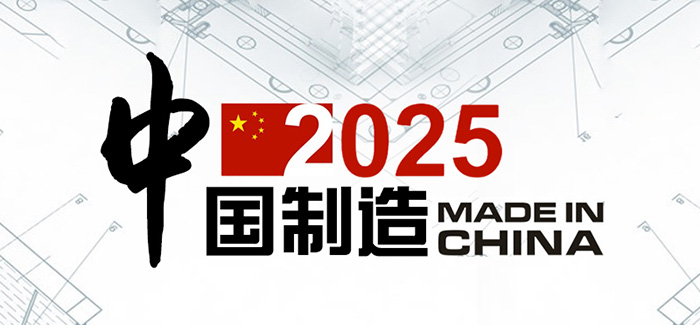U.S.-China Relations at 50: Learning Lessons and Moving Ahead
A half-century of experience points to the need for stronger measures to address future challenges.
BY ROBERT S. WANG

In Beijing on Feb. 15, 1972, China and the U.S. opened official diplomatic relations for the first time since the Communist Party took over China in 1949. From left to right: Chinese Premier Zhou Enlai, interpreter Nancy Tang, Chairman of the Communist Party of China Mao Zedong, U.S. President Richard Nixon and U.S. National Security Adviser Henry Kissinger.
Keystone Press Agency / Zuma Wire / Alamy Live News

From the 1960s Cultural Revolution, this Chinese propaganda poster reads: “Long live Chairman Mao, the reddest sun in our hearts.” The crowd holds aloft his Little Red Book.
Shawshots / Alamy
In its Indo-Pacific Strategy of the United States (February 2022), the Biden administration highlighted mounting challenges in Asia, particularly as the People’s Republic of China “pursues a sphere of influence in the Indo-Pacific and seeks to become the world’s most influential power.” The strategy document asserts: “From the economic coercion of Australia to the conflict along the Line of Actual Control with India to the growing pressure on Taiwan and bullying of neighbors in the East and South China Seas, our allies and partners in the region bear much of the cost of the PRC’s harmful behavior. In the process, the PRC is also undermining human rights and international law, including freedom of navigation, as well as other principles that have brought stability and prosperity to the Indo-Pacific.”
Meanwhile, in the wake of Russia’s brutal invasion of Ukraine, Beijing abstained on the United Nations resolution condemning the invasion, echoed Russia’s claims about U.S. and NATO responsibility for the crisis, and refused to join the United States and European Union in imposing economic sanctions on Russia. In fact, after their meeting in Beijing earlier in the month, Presidents Xi Jinping and Vladimir Putin announced that the two countries “oppose further enlargement of NATO” and “stand against the formation of closed bloc structures and opposing camps in the Asia-Pacific region and remain highly vigilant about the negative impact of the United States’ Indo-Pacific strategy on peace and stability in the region.” Further, they “reaffirm that the new inter-State relations between Russia and China are superior to political and military alliances of the Cold War era,” and that “there are no ‘forbidden’ areas of cooperation.”
Thus it appears that U.S.-China relations are at a critical stage as an increasingly powerful and authoritarian China has become more aggressive in pursuing its irredentist regional goals in alliance with Putin’s Russia, which not only threatens U.S. democratic allies and partners in Asia but could also undermine the rules and values of the U.S.-led liberal international order across the globe. Russia’s invasion of Ukraine—following its previous military operations in Georgia and Crimea, as well as intervention in Syria—serves as a useful “wake-up call” for the United States and its allies in Asia.
In this article, I will reflect on U.S. policy toward China over the past 50 years and briefly offer my thoughts on the lessons we should have learned that will, hopefully, be useful in addressing the growing challenges we will face from China. In this I draw partly on my own experiences during a 32-year Foreign Service career that has been focused primarily on U.S.-China relations.
Was U.S. Engagement Policy a Mistake?
In the November/December 2021 Foreign Affairs, John Mearsheimer called U.S. engagement policy toward China “a colossal strategic mistake,” arguing that in recent history “there is no comparable example of a great power actively fostering the rise of a peer competitor. And it is now too late to do much about it.” Mearsheimer wrote: “Washington promoted investment in China and welcomed the country into the global trading system, thinking it would become a peace-loving democracy and a responsible stakeholder in a U.S.-led international order.” Nonetheless, he posited, “China has always had revisionist goals” that were opposed to this order, and “the mistake was allowing it to become powerful enough to act on them.”
In a subsequent rebuttal, G. John Ikenberry pointed out that U.S. engagement policy toward China had been part of a largely successful effort to create a postwar order in which “the United States pushed and pulled the international system in a direction that broadly aligned with its interests and values, promulgating rules and institutions to foster liberal democracy, expanding security cooperation with European and East Asian allies, and generating international coalitions for tackling the gravest threats to humanity.” In this process, he noted, “Washington built counterweights to Chinese power through an invigorated and deepened alliance system” and “regional institutions in the broader Asia-Pacific region.” Ikenberry concluded: “The major failure of U.S. strategy toward China was to not make the country’s integration into the liberal capitalist system more conditional.” And he called on the United States “to work with its allies to strengthen liberal democracy and the global system that makes it safe—and to do so while looking for opportunities to work with its chief rival.”
While Beijing has been open to dialogues and negotiations, we have few results to show for them.
As I see it, to accept Mearsheimer’s basic thesis would essentially be to disavow the fundamental objectives of U.S. postwar foreign policy that we in the Foreign Service have worked to advance, even if often unsuccessfully. Even during my posting in Hong Kong during the Tiananmen massacre in June 1989, when we witnessed and offered assistance to the flood of political refugees coming out of the mainland, we retained hope that keeping China’s door open would eventually lead to its transformation into a more open and just society. We continued to work to promote bilateral ties during my tours in Shanghai in the mid-1990s, and then in Beijing in the early 2000s when China entered the World Trade Organization, and a decade later even as China began to assert and expand its regional presence and global reach.
At the same time, it also became increasingly clear to me, especially during my last tour in Beijing (2011-2013) and over the past decade, that U.S. engagement policy had failed to alter China’s autocratic political system or to transform Beijing into a “responsible stakeholder” in the international arena, while propelling its rapid economic and military rise and enabling it to pursue an increasingly assertive foreign policy. Nonetheless, I continue to maintain that while this policy has not succeeded thus far, its long-term objectives remain valid and achievable. As Richard Nixon himself wrote in a prescient article in the October 1967 Foreign Affairs: “Taking the long view, we simply cannot afford to leave China forever outside the family of nations, there to nurture its fantasies, cherish its hates and threaten its neighbors.” At the same time, he pointed out, this policy requires “recognizing the present and potential danger from Communist China, and taking measures designed to meet that danger.” Nixon warned: “We could go disastrously wrong if, in pursuing this long-range goal, we failed in the short range to read the lessons of history.”

Tiananmen Square in 2016.
Morio
Learning Lessons

Signboards for a protest in Hong Kong feature South China Sunday Morning Post coverage of the People’s Republic of China government crackdown on demonstrators on June 4, 1989, in Beijing’s Tiananmen Square.
Brian Harris / Alamy
So what went wrong, and what are “the lessons of history” we now must learn to be able to take the necessary measures to confront China’s “present and potential danger”? I focus here on two critical lessons I have derived over the years.
1. Don’t underestimate the determination and ability of the ruling Chinese Communist Party to maintain its absolute power and resist political change.
I believe this is the most fundamental “lesson of history” that we should have learned since U.S. engagement policy began 50 years ago. From the Democracy Wall (1979) and the June 4 Tiananmen Massacre (1989) to the crackdown on the Falun Gong (1999), the Jasmine Revolution (2011) and the Hong Kong Democracy Movement (2019-2020), the CCP has amply demonstrated its determination and ability to stifle political dissent, suppress individual freedoms and resist political change in China. This process notably included the purge of some of its own top leaders, such as Hu Yaobang and Zhao Ziyang in the 1980s. In fact, even as Deng Xiaoping revived economic reforms after 1989, the CCP actually tightened political control, especially after the collapse of the Soviet Union that year.
The CCP has imposed draconian measures in Tibet and Xinjiang in its effort to suppress “separatist” movements among ethnic minorities in China. Under Xi Jinping, the CCP’s quest for control has redoubled and reverted into the economic realm, targeting not only state-owned enterprises but both domestic and foreign private companies operating in China, and expanded into society at large with widespread surveillance and censorship and the initiation of “social credit scores” to assess citizens’ political loyalty. Finally, Beijing has put aside Deng’s “hide and bide” caution and begun to flex its increasing economic and military power abroad to advance Xi’s “China dream.”
Nonetheless, as an open letter to President Donald Trump in 2019 shows, many China analysts, including former U.S. diplomats, reject an adversarial stance toward Beijing. They continue to believe, as they wrote to Trump, that while China’s “challenges require a firm and effective U.S. response,” the recent measures taken by the United States “are fundamentally counterproductive” and contribute “directly to the downward spiral in relations” that “we believe does not serve American or global interests.” In the letter these authors argued that U.S. policy “must be based on a realistic appraisal of Chinese perceptions, interests, goals and behavior,” and that China is not “a monolith, or the views of its leaders set in stone.”
They stated: “Although its rapid economic and military growth has led Beijing toward a more assertive international role, many Chinese officials and other elites know that a moderate, pragmatic and genuinely cooperative approach with the West serves China’s interests. Washington’s adversarial stance toward Beijing weakens the influence of those voices in favor of assertive nationalists. With the right balance of competition and cooperation, U.S. actions can strengthen those Chinese leaders who want China to play a constructive role in world affairs.”
But the question remains: Why had the United States not responded earlier to China’s egregiously unfair trade practices?
While I, too, want to hold out hope that Beijing will eventually undertake political reforms and adopt constructive policies abroad, I now believe it has become too dangerous to assume the CCP will allow this to happen absent a much stronger—and even “adversarial”—response from the United States and others. In opening our markets and encouraging investments in China, we had assumed an increasingly prosperous and internationally connected Chinese middle class and intelligentsia would eventually demand political reforms, as we have witnessed elsewhere in Asia, and more cooperative ties with the West. Many were—and continue to be—convinced that the “end of history” and rise of innately superior democracies was and is close at hand.
This clearly has not happened, and China has even moved backward under the current CCP leadership. Yet we continued to facilitate China’s economic rise, which allowed the CCP to tout the “Beijing model” to its own people (“socialism with Chinese characteristics”) as superior to Western democracies and enabled the CCP to strengthen its internal controls. Ironically, the CCP has now joined with Russia to accuse the United States of adopting a “Cold War approach,” while further mobilizing nationalist sentiments to support its aggressive foreign policy goals.
To arrive at the “realistic appraisal of Chinese perceptions, interests, goals and behavior” demanded by critics of the Trump policy, it might also be useful for us to look back at the CCP’s long history of violent political struggles, such as the anti-rightist campaigns of the 1950s and the Cultural Revolution in the 1960s and 1970s. Reviewing this history up to the present should strongly suggest that political changes will not come about without a much more significant pushback, even if this does result in increased tension and a deterioration in relations. Our continued unwillingness to accept this reality and the risks of confrontation over the years has led us to where we are today. I think it is time to readjust our expectations and consider new measures to confront China’s challenges.
2. Don’t assume that China’s internationalization and growing interdependence with the world will transform it into a “responsible stakeholder.”
“Our policy has succeeded remarkably well in expanding China’s international role,” then–Deputy Secretary of State (and former U.S. Trade Representative) Bob Zoellick said in a speech in 2005. But noting an “unacceptable” $162 billion bilateral trade deficit with China, he added: “The U.S. business community, which in the 1990s saw China as a land of opportunity, now has a more mixed assessment. Smaller companies worry about Chinese competition, rampant piracy, counterfeiting and currency manipulation. Even larger U.S. businesses—once the backbone of support for economic engagement—are concerned that mercantilist Chinese policies will try to direct controlled markets instead of opening competitive markets.”
Zoellick warned that China “cannot take its access to the U.S. market for granted” because “the United States will not be able to sustain an open international economic system—or domestic U.S. support for such a system—without greater cooperation from China.” Said Zoellick: “As a responsible stakeholder, China would be more than just a member—it would work with us to sustain the international system that has enabled its success.”
Now, nearly two decades later, there is little doubt that China has not become the “responsible stakeholder” Zoellick envisioned. To begin with, while not in itself an indicator of trade practices, the U.S. trade deficit with China reached $355.3 billion in 2021. More to the point, as reported in the 2018 USTR Section 301 report, the U.S. Intellectual Property Commission estimated that “Chinese theft of American IP currently costs between $225 billion and $600 billion annually.” The commission found China to be “the worst infringer of American IP” and that “China effectuates forced technology transfer and theft including via industrial espionage, conditioning market access on technology transfer, tactical employment of vague regulations and laws to pressure U.S. firms into transferring their IP to avoid litigation and localization requirements that force U.S. firms to house sensitive data on the Chinese mainland.” The USTR report concluded: “The evidence adduced in this investigation establishes that China’s technology transfer regime continues, notwithstanding repeated bilateral commitments and government statements.”
We need to be willing to take stronger measures—and accept the necessary costs and risks—to achieve the long-term goals of the U.S. engagement policy that commenced 50 years ago.
Even more troubling for the future, the USTR report explains that “China has issued a large number of industrial policies, including more than 100 five-year plans, science and technology development plans, and sectoral plans over the last decade” to attain global leadership in key strategic industries, including information technology, robotics, aircraft, energy and pharmaceutical industries. The Made in China 2025 (MIC 2025) Plan, the report says, “sets forth clear principles, tasks and tools to implement this strategy, including government intervention and substantial government, financial and other support to the targeted Chinese industries,” as well as “foreign technology acquisition through various means.”
In an August 2020 “In Focus” update, the U.S. Congressional Research Service reported that “Chinese government guidance funds (GGFs) channel state funding to Chinese companies in support of domestic R&D and overseas acquisitions,” and “as of March 2018, an estimated 1,800 GGFs linked to MIC 2025 were collectively valued at $426 billion.” CRS stated: “GGFs target and fund strategic acquisitions that appear to build Chinese capabilities through control of foreign corporate expertise, IP, talent pools, and ties to suppliers and customers.”
Based on these assessments and after numerous rounds of negotiations, the United States finally took action to raise tariffs on more than $350 billion of Chinese imports in different tranches. It took steps to mandate a national security review of Chinese investments in 27 “critical technology” industries and tightened scrutiny of Chinese business operations in the United States.
But the question remains: Why had the United States not responded earlier to China’s egregiously unfair trade practices, as Zoellick suggested we might, and why do many continue to oppose current and future measures? One answer is provided in the USTR Section 301 report: “U.S. companies have stated for more than a decade, they fear that they will face retaliation or the loss of business opportunities if they come forward to complain about China’s unfair trade practices.” Moreover, American companies have lobbied against and sought exclusions from the recent tariff measures applied on Chinese imports that affect their business operations.
Beijing has long recognized the important role of the private sector in Western democracies and has not hesitated to use its leverage to pressure the United States from taking action not only against China’s trade practices but on political and security issues, as well. In my experience in China, we came to expect visits from U.S. businesses under pressure from the Chinese government whenever bilateral tensions escalated, and this has now been extended to individuals and businesses in the United States. We have also seen such pressures applied by Beijing against other countries, as in the cases of Australia (over investigation of the origins of COVID-19) or Korea (over deployment of U.S. missile defense systems). Hence, while we had hoped that increased global interdependence would encourage China to be more responsible, it appears, on the contrary, to have primarily increased Beijing’s leverage against the rest of the world.
At the same time, while Beijing has been open to dialogues and negotiations, we have few results to show for them. I recall that a PRC Foreign Ministry official remarked at the end of my last tour in Beijing that China and the United States had conducted more than 90 annual dialogues by 2013 across a full spectrum of subjects from trade and security to labor, law enforcement and human rights. On occasion, “successful” talks have led to “commitments” and “agreements”—but, as we used to advise American companies, the real negotiation begins after contracts are signed. Our bilateral history is replete with such examples, going back to the 1996 Sino-U.S. Intellectual Property Agreement and the recent “historic and enforceable” U.S.-China Phase One Trade Agreement. Beijing has been skillful in using dialogues and agreements—as well as the WTO—to delay and divert retaliatory actions by other parties, while China continues its policies and practices.
Finally, Beijing has continually used cooperation on “common interests,” such as climate change and nuclear nonproliferation (North Korea and Iran), as leverage to exact concessions from the United States on bilateral issues. As China’s Foreign Minister Wang Yi openly told U.S. Special Presidential Envoy for Climate John Kerry in September 2021: “Cooperation on climate change cannot be divorced from the overall situation of China-U.S. relations. The United States should work with China to meet each other halfway and take positive actions to bring China-U.S. relations back on track.” He urged the United States to “stop viewing China as a threat and rival, and cease containing and suppressing China all over the world” and “actively respond to the ‘two lists’ and ‘three bottom lines’ put forward by China, and take concrete steps to improve China-U.S. relations.”

PRC Foreign Minister Wang Yi, shown here addressing the Munich Security Conference in 2017, insists that cooperation must involve U.S. concessions to China.
Kleinschmidt / MSC
Moving Ahead
From the above, it is clear that it will be very difficult for the United States to convince Beijing to undertake political reforms or assume the role of a “responsible stakeholder” in the present international order.
Former Assistant Secretary and current National Security Council Coordinator for the Indo-Pacific Kurt Campbell wrote in 2018: “The starting point for a better approach is a new degree of humility about the United States’ ability to change China. Neither seeking to isolate and weaken it nor trying to transform it for the better should be the lodestar of U.S. strategy in Asia. Washington should instead focus more on its own power and behavior, and the power and behavior of its allies and partners.” Similarly, the 2022 U.S. Indo-Pacific Strategy underscores that “our objective is not to change the PRC but to shape the strategic environment in which it operates, building a balance of influence in the world that is maximally favorable to the United States, our allies and partners, and the interests and values we share.” It indicates that we will continue to work with the PRC in areas like climate change and nonproliferation, believing that “it is in the interests of the region and the wider world that no country withhold progress on existential transnational issues because of bilateral differences.”

Made in China 2025 is a long-term PRC plan to boost China’s international competitiveness.
www.gov.cn
As I see it, however, the lesson we should have learned is not that we cannot and should not seek to change China, as it continues to violate international trade rules and laws and universal human rights principles. Rather, it is that we need to be willing to take stronger measures—and accept the necessary costs and risks—to achieve the long-term goals of the U.S. engagement policy that commenced 50 years ago. In his 1967 article, Nixon warned: “The world cannot be safe until China changes. Thus our aim, to the extent that we can influence events, should be to induce change. The way to do this is to persuade China that it must change: that it cannot satisfy its imperial ambitions, and that its own national interest requires a turning away from foreign adventuring and a turning inward toward the solution of its own domestic problems.” If we allow China to continue to take advantage of the present global order to pursue its economic growth, then I believe we are simply postponing the day of reckoning, as we now see more clearly in the case of Russia.
So what specifically should the United States do? I argue here that, apart from defensively “shaping the strategic environment” around China, we can and should start by taking direct and stronger measures to ensure that China cannot continue to pursue the egregious trade practices that have enabled its economic and military rise and enhanced its internal controls. It is critical that President Joe Biden has retained the Section 301 trade measures taken by the previous administration, but more needs to be done, including immediate action to enforce the Phase One Agreement Beijing has clearly not fulfilled. The United States should act to impose stronger sanctions on Chinese entities that violate U.S. intellectual property rights and promote China’s industrial policies. While remaining open to work on “common interests,” the U.S. should reject any linkage to other bilateral issues and minimize further dialogues and negotiations that are simply meant to delay U.S. action. To enhance the impact of these measures, the United States should collaborate with our allies and within the WTO; but we should not hesitate to act on our own as soon as possible.
At the same time, the United States should work with the European Union and other democracies, as well as relevant nongovernmental organizations, to document and publicize even more widely Beijing’s gross human rights violations within China, especially against the Uyghur population in Xinjiang, and its policies that support authoritarian regimes abroad, including its indirect support for Russia’s invasion of Ukraine. Ultimately, it will be up to the Chinese people to decide on their own political system, but we need to continue supporting those in China who seek to advance political reforms and more constructive policies abroad. We cannot do that by just avoiding confrontation. We should take further steps to support the individual rights and freedoms of the people of Hong Kong, as well as assist the people of Taiwan in their fight to determine their own political future. As Martin Luther King wrote in 1963: “Injustice anywhere is a threat to justice everywhere.”
The clear message we should be sending by these actions is not that the United States is seeking to weaken China, but that China can continue to prosper only if it abides by the rules of the international order from which it has greatly benefited. Given China’s interdependence with the world, the United States and its allies do have important leverage, but only if we are able to mobilize domestic and international support to use it. Doing so will be very difficult; and, frankly, I am not confident that it can be done as things stand today in the United States. Apart from Beijing’s retaliation against American businesses and industries, as well as more recent concerns about inflationary pressures in the U.S. economy, there will continue to be opposition from those concerned about the risks of an “adversarial” approach and the dangers of a “new Cold War.” But I would still argue that we cannot afford to wait much longer. As Nixon warned in 1967, “we could go disastrously wrong if, in pursuing this long-range goal, we failed in the short range to read the lessons of history.”
Read More...
- “Countering China’s Intimidation of Taiwan,” by Robert S. Wang, The Foreign Service Journal, June 2021
- “China’s Economic Growth: Source of Disorder?” By Robert S. Wang, The Foreign Service Journal, May 2005
- “Is American Diplomacy with China Dead?” by Susan A. Thornton, The Foreign Service Journal, July-August 2019
- “Working with Dulles: An Insider’s Account of the Taiwan Strait Crisis,” by Marshall Greene, The Foreign Service Journal, May 1989






